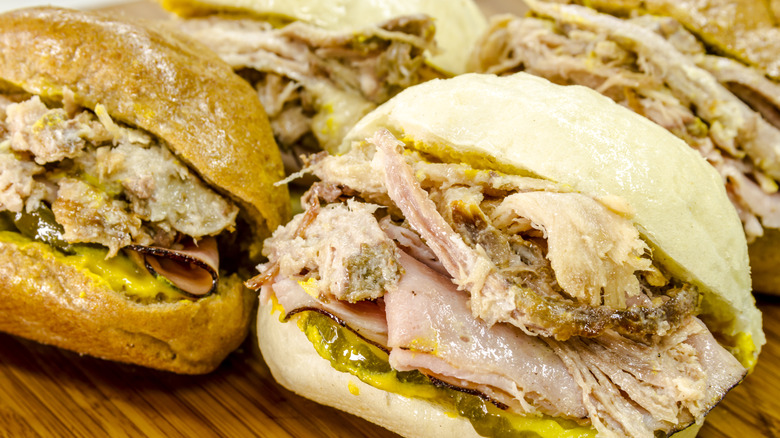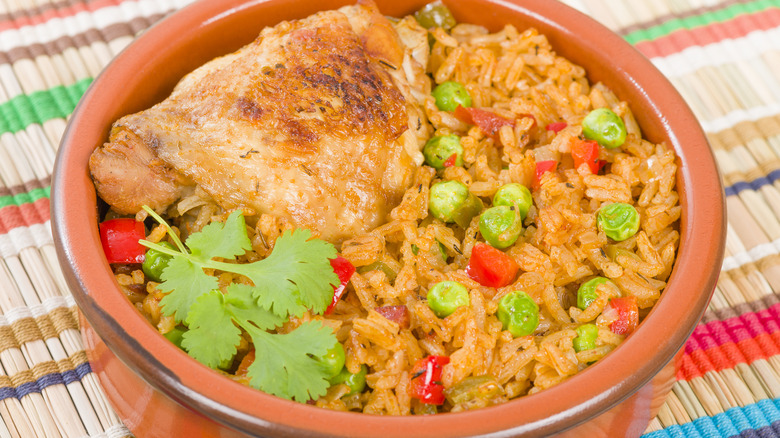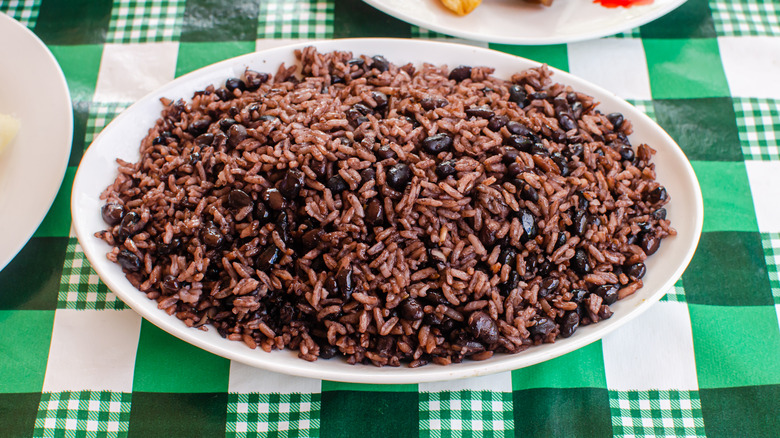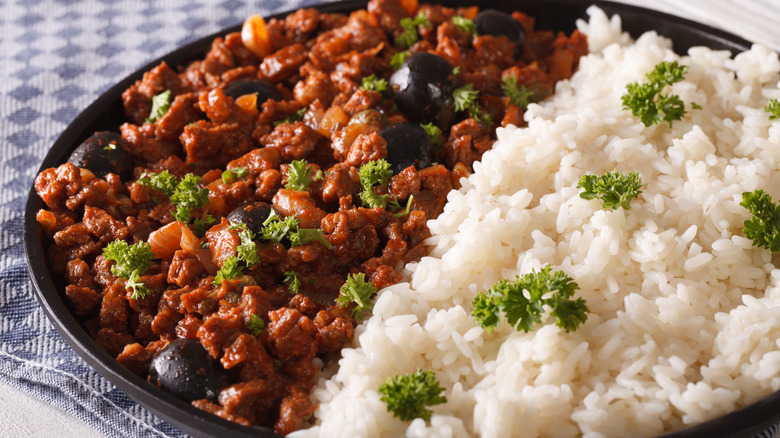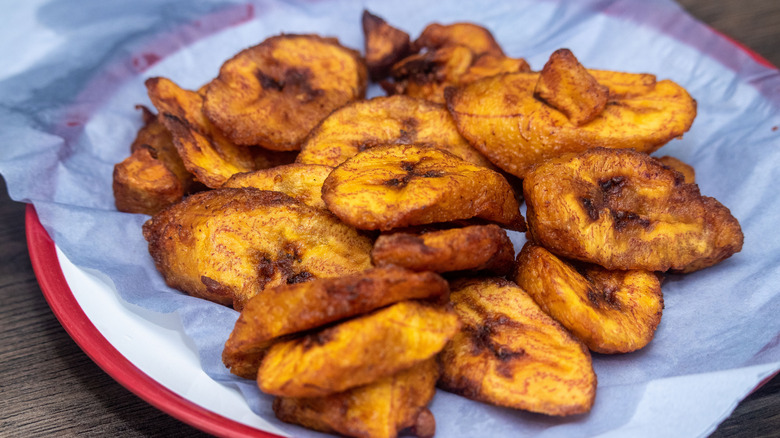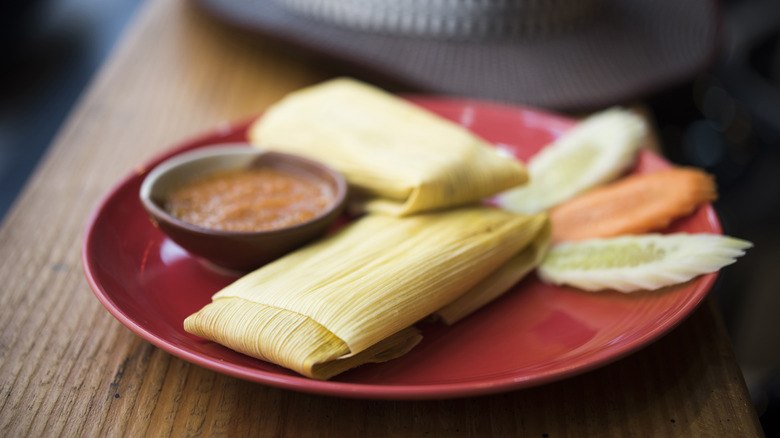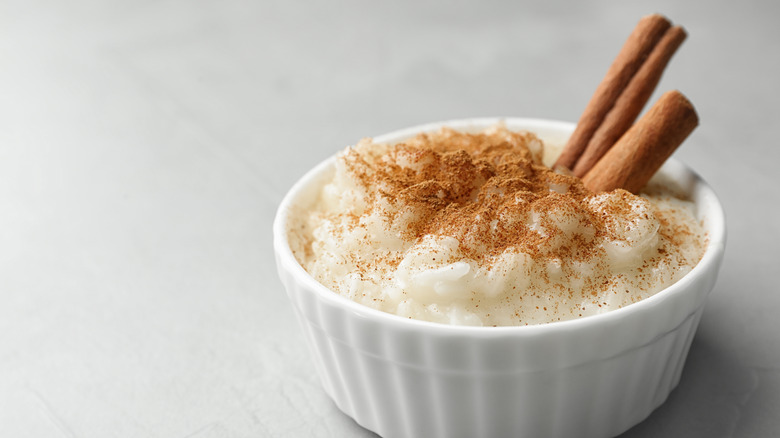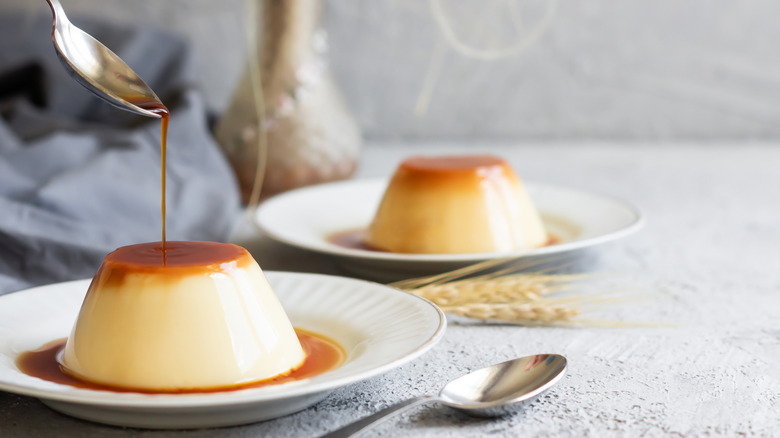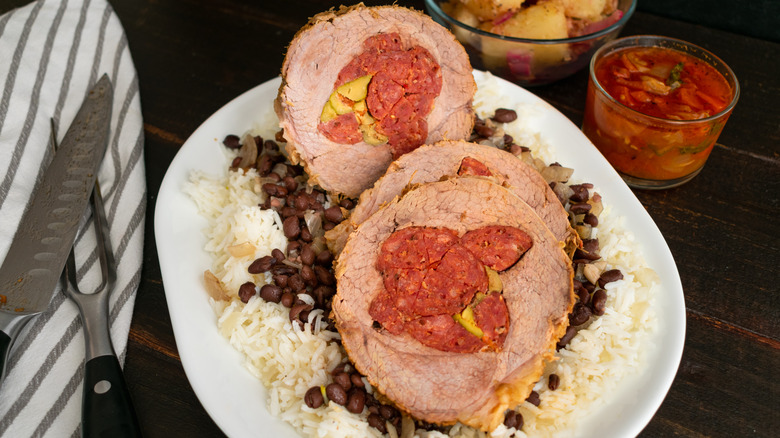34 Cuban Foods You Need To Try At Least Once
We may receive a commission on purchases made from links.
Although booking a direct flight to Cuba remains a hassle for American travelers, a culinary trip to the island is easily within reach. Cuban food tells the story of the country's history, which is built on influences from a wide range of origins. Spanish, African, Caribbean, indigenous, and Chinese cuisine all play a role in modern-day Cuban food. The dishes reflect the agricultural and geographical features of Cuba and include many starchy root vegetables, tropical fruits, and seafood from the surrounding coast. As for rice — a staple across Latin America — it owes its arrival on the island to Chinese immigrants.
Rough Guides opines that Cuban food can be lacking in piquant and exciting novel flavors; however, classic local dishes are heartwarming in a way that no gourmet cuisine can be. A focus on local produce means that the dishes are made with freshness in mind. Whether you choose to head to the kitchen and recreate your own version of these Cuban (and Cuban American) specialties, find them in a restaurant, or travel to Cuba itself, expect simple and satisfying flavors.
1. Cuban sandwich
Despite its name, the modern version of the Cubano or Cuban sandwich may have actually originated in Southern Florida, Thrillist reports. The source explains that the sandwich has evolved since its first, fish-based rendition by the indigenous Taino tribe around 500 years ago. Centuries of external influence transformed the dish into a pork-centric creation. Food chemist Jorge Astorquiza explains to Thrillist that Cuban immigrants were making a slightly different version in Florida and decided to name the sandwich after their country to distinguish it from the original. Basically, with the ingredients they had available, it became the Americanized version of a dish from their homeland.
A few elements set the sandwich apart from just any meat and bread combination. Food Fun Travel notes that, first and foremost, you'll need Cuban bread. The wheat bread is made with yeast and a bit of lard, producing a crispy exterior and a light interior. More importantly, a palmetto leaf (aka cabbage leaf) is wrapped around the dough as it rises, providing extra flavor. As for the fillings, the cities of Tampa and Miami engage in a salami debate (the addition is preferred in Tampa but eschewed in Miami, per NPR) but we'll stick to the basics: smoked ham, roast marinated pork, Swiss cheese, mustard, and, specifically, three pickles. The sandwich can be served as is or pressed between two hot griddles like a panini.
2. Medianoche
Medianoche means "midnight" in Spanish, and that is exactly the time at which you'd want to gobble up this sandwich to fuel your night of dancing and soak up excess alcohol. All the same, it's a perfectly viable option any time of the day. A medianoche is certainly similar to a Cuban sandwich as far as the fillings go, but a fundamental distinction should be noted. While the Cuban sandwich is made with a lard-based bread that has a crunchy exterior, a medianoche is made with pan suave, which translates to "soft bread." Plus, the bread is made with eggs, which add a subtly sweet flavor and a pleasant texture, not unlike Jewish challah bread.
The first medianoche is thought to have originated in Havana in the early 1900s. It wasn't late-night partiers but workers who came up with the satisfying creation. As with a Cubano, the fillings consist of smoked ham, roast marinated pork, Swiss cheese, and pickles. For the ultimate experience of gooey melted cheese, it's often pressed in a griddle.
3. Ropa vieja
You might want to ignore the English translation — "old clothes" — and instead focus on the delicious flavors of the dish. The origin is not limited to Cuba, and versions of ropa vieja are popular around the Caribbean. According to Latin Post, an old legend tells the story of a poor man who cooked his clothes to feed his family. During the process, a guardian angel helped him out by turning the clothes into meat and vegetables. The nourishing dish is composed of shredded beef, cooked with bell peppers and onion in a tomato-based sauce, and served with rice.
Long before the dish arrived in Cuba sometime in the mid-1800s, it was a dining staple in the Canary Islands. Besides rice, the dish is commonly served with beans or fried plantains, whereas in the Canary Islands, boiled potatoes are the main go-to pairing.
4. Lechon asado
Lechon asado could be viewed as an ode to pork. The dish is typically found at any large celebration and is traditionally served on Christmas Eve. Although you can eat this any day of the year, the long preparation tends to warrant a special occasion. The dish is cooked in a charcoal-fueled closed grill (aka a Chinese box like La Caja China on Amazon), another hint at the Chinese influence in Cuban cuisine. However, before any meat is to be grilled, it must first be marinated in an adobo sauce packed with citrus, garlic, cumin, and oregano. Eventually, a suckling pig (or a pork shoulder or loin if you can't find a whole hog) is slow-roasted for hours.
You'll end up with fall-off-the-bone meat and crispy skin. Serve the meat with mojo sauce for more citrus, garlic, cumin, and oregano flavors. As for a side dish, when in doubt Cubans are always fond of rice. Black beans and rice are a popular accompaniment, as well as boiled cassava drizzled with more mojo sauce.
5. Ajiaco Cubano
As far as old recipes go, ajiaco dates back to the pre-Columbian period, according to Smithsonian Magazine. The dish gets its name from aji, a chili pepper that provides plenty of depth of flavor. The slow-cooked stew has certainly gone through its own evolution of everchanging meats, but root vegetables are a constant in the preparation. It's typically comprised of stewed meats, vegetables, and spices with American, European, and African influences. Think of it as the ultimate one-pot meal — nourishing and packed with flavor.
Versions of ajiaco can be found across Latin America, and the specific ingredients vary based on availability and regional styles. In Cuba, a sauté of onions, garlic, peppers, and spices, known as sofrito, makes up the base of the dish. Beyond that, the stew may incorporate dried meat, sweet potatoes, pumpkin, tomatoes, and even plantains. The beauty of the dish is that the bulk can be filled in based on the ingredients you have available. Talk about the perfect comfort food!
6. Fricasé de pollo
Chicken is a popular protein in Cuba, and there are countless ways to enjoy it. According to 196 Flavors, Fricasé de pollo is inspired by the French chicken stew, fricassée. The dish can, in fact, be traced to various cultures, each providing their own touch. The ingredients are both sautéed and stewed, which gives the dish maximum flavor. The French fricassée is made with a creamy sauce and white chicken meat, whereas the Cuban version opts for brown meat cooked in a tomato-based sauce.
Per 196 Flavors, the chicken is first marinated in a citrusy, garlicy mojo, providing lots of flavor. Aside from tomatoes, chicken thighs and legs are stewed in a combination of garlic, onions, bell peppers, potatoes, olives, stock, and spices like cumin and coriander. Once the potatoes and chicken are fully cooked, the saucy dish can be served with rice or warm Cuban bread.
7. Vaca frita
Vaca frita is a direct description of what you'll be served: fried beef. It's not deep-fried but instead, it is first boiled until the meat softens, 196 Flavors explains. Then, the beef is shredded, marinated in garlic, lime juice, and salt, and finally pan-fried until it is pleasantly crispy, according to Britannica. The source adds that flank or skirt steak are common cuts used for the preparation since they are lean and dry out fairly quickly. Generally, bell peppers, onions, and additional seasonings are fried with the meat to add more flavor.
The simple yet tasty dish goes well with classic Cuban sides: think white rice, black beans, fried plantains, and plenty of lime juice. The crunchy texture is a welcome contrast to the softer accompaniments, making for a winning combination. While the shredded beef aspect is similar to ropa vieja, the two dishes have substantially different preparations and final results.
8. Pulpeta
Meatloaf tops many a list of comfort foods, and Cuba happens to have a version of the classic dish. Pulpeta is a combination of ground beef, pork, and ham, as well as eggs (for binding as well as a whole hard-boiled egg stuffed in the center), onions, vinegar, cheese, breadcrumbs, tomato, wine, and herbs to tie the whole dish together. Once the meatloaf is formed, the exterior is coated in breadcrumbs and fried to create a crispy outer shell. Finally, the fried meatloaf stews in a richly seasoned Creole tomato and bell pepper sauce to fully coat it in layers of flavor (via Bean Train).
Hispanic Food Network notes that there can be a smoky undertone to the sauce, perhaps somewhat reminiscent of BBQ sauce. Fresh parsley often acts as an herbal garnish to offset the sweetness. Traditional Cuban sides including fried plantains and rice are often paired with the dish. Pulpeta is also regularly served with another classic comfort food that's enjoyed internationally: mashed potatoes. If you can imagine the delicious sauce as gravy, you'll realize why this combination is so great.
9. Arroz con pollo
Arroz con pollo (aka "rice with chicken") is another fuss-free dish that is as simple as it's delicious. Most countries across Latin America have some version of the meal, and Amigo Foods remarks that it is among the most popular dishes consumed in the region. The source reports that the origin of the dish is believed to come from the Moors — Muslim inhabitants who invaded Spain in the medieval period. The dish can easily be customized and once you taste it, you'll quickly understand why it is a staple in so many countries.
The Durango Herald describes the nuances of the dish that provide so much flavor. First, the rice is boiled in chicken fat that is saved after frying up the chicken thighs. The rice is combined with stock, beer, tomato sauce, and saffron, which adds a distinct earthy aroma. A classic sauté of onions, bell peppers, and garlic creates a rich foundation that infuses plenty of aromas to the dish. Once the rice is cooked, the crispy chicken thigh is served on top.
10. Congrí
Congrí is also named arroz con moros y cristianos, which has a culturally relevant meaning regarding the various ethnicities present in Cuba historically. The dish highlights a battle centuries ago between Spanish Christians and Muslim Moors. In fact, "moros" refers to the darker-skinned Moors as well as to the black beans in the dish, whereas the rice is termed "cristianos" for the white Spaniards (via Cuba Plus). The source remarks that the dish is likely of African origin and various renditions exist in surrounding countries.
The rice and beans are cooked with the classic sofrito flavor base of onions, garlic, bell peppers, cumin, and bay leaves. When the rice and beans are cooked together, the rice takes on a grayish color, which Food52 indicates is where the name congrí comes from — "con gris," which is Spanish for "with gray." Chopped bacon or chorizo are sometimes included to provide extra flavor and protein. The dish can be served as a frugal main course or as a side paired with a meat-centric main like ropa vieja or lechon asado.
11. Arroz imperial
Rice is certainly at the heart of many Cuban dishes, and this is no exception when it comes to arroz imperial. The dish contains a lengthy list of ingredients, including regulars like chicken, bacon, sofrito (a garlic, bell pepper, and onion sauté), as well as green peas, mayonnaise, and cheese. Imagine layered rice crossed with a cheesy lasagna, plus plenty of extra mayo and sauce to make the dish especially creamy. Much like a baked casserole, the top layer is browned during the cooking time.
World Food Guide indicates that while it's not as ubiquitous arroz con pollo, the preparation is still a popular one. Served as a side dish or main course, arroz imperial's layered presentation makes it particularly eye-catching. Unlike some other Cuban dishes with straightforward origins, the influences that led to the creation of arroz imperial are hard to place.
12. Picadillo
Picadillo comes from the Spanish word "picar," meaning to chop, which is an essential part of the preparation. There's no straightforward rule as to what meat is used in the recipe, especially as there are many variations of picadillo, although a traditional Cuban recipe is made with ground beef. Nevertheless, this is the type of dish that can be prepared using whatever is available. On top of the meat, vegetables and seasonings are incorporated, varying depending on the region. Raisins, olives, and even capers can make an appearance in some styles of the dish, which The New York Times labels "the ultimate Cuban comfort food."
Picadillo can be a filling, say for an empanada, but it also pairs well with plain rice and potatoes. A comparison can be made with the meat mince that makes up a sloppy Joe, as The New York Times points out. Thanks to the versatility of the ingredients and its easy preparation, picadillo is a common meal in many Cuban homes.
13. Enchilado de camarones
Sifting through the endless meat-based recipes fundamental to Cuban cuisine, it's easy to forget that the country is an island. It follows that along the coast, seafood is an important part of what is being served. Enchilado de camarones is a shrimp stew, which 196 Flavors identifies as coming from neighboring Haiti. The sauce is tomato and pepper based, flavored with spices, and often prepared with wine.
As with many Cuban recipes, the shrimp is marinated in a citrus sauce prior to being cooked (via 196 Flavors). The shrimp are first pan-fried, and later added to the enchilado sauce to stew as they fully absorb the additional flavors. Plain white rice or a pilaf make an easy accompaniment to soak up the sauce, and fresh cilantro adds some contrast. The same preparation can be made with other seafood, such as crab or white fish.
14. Platanos maduros
Platanos maduros (or "ripe fried plantains") are a common side dish and snack across Latin America, West Africa, and India where they likely originated. Surprisingly, plantains, which are related to bananas, were brought to the Caribbean by the Spanish. The food is now so deeply rooted in Cuban culture, that the term "aplatanado" (basically "plantainized") is used when a foreigner becomes enmeshed with the local culture and customs.
The starchy fruit must be cooked, and the dish takes advantage of the extra sugars that build up as the fruit ripens. Oil, butter, and salt are just about all that goes into the preparation. Although they can be served as a side for just about any rice and meat dish, the fried plantains make a great snack with a bit of lime juice and avocado. For a crunchier take, plantains can be flattened into discs and deep-fried as tostones, not unlike a cross between a chip and a french fry in texture. If you're not in the cooking mood, you can also grab yourself a bag of tostones from Goya.
15. Tamales
Popular across Latin America, tamales vary regionally but generally consist of masa (a corn-based dough) wrapped in a corn husk and steamed, though they can be roasted, grilled, or fried. Thanks to the husk, the corn filling doesn't dry out and manages to absorb extra flavors and seasoning. The preparation and additional fillings can vary widely between countries and cooks. As for the Cuban style, Taos News explains that fresh corn kernels are commonly used instead of a finer flour-like mass. Seasoned pork is a common add-in, and in areas where bananas grow, the fruit's leaves are used to wrap up the masa instead (via Taos News).
Homemade versions abound, which isn't surprising since tamales have been around for millennia. Ethnic Spoon indicates that they were consumed in Pre-Columbian times by the Aztecs and Mayans, and they were commonly served at festivals, which is no wonder when you consider the conveniently wrapped format. The corn-based snack is often sold as street food, easily transported and ready to unwrap when the time comes. If you've never tried a tamale, the husk is merely used for cooking and to infuse flavor — you don't want to try eating it!
16. Croquetas
Every cuisine deserves crispy bite-sized snacks, and in Cuba they are found as croquetas. As with many culinary creations, the food originated in France as a way to use up leftovers by forming them into a mass within a breadcrumb shell and frying it. Meat or potatoes are common fillings, but what sets croquetas apart from other fried morsels is that they contain a creamy bechamel sauce as well. An order usually comes with a pile of croquetas, which are either tubular or round. The snack is common both in Cuba and in Miami, and it's easy to see why the warm savory treat goes down so well.
Just be careful if you are buying pre-made ones in Cuba from state-owned distributors, as multiple people have experienced severe burns as a result of an exploding croqueta. NBC News notes that croqueta company Prodal released a statement warning people to heat the cooking oil only to 180 degrees Fahrenheit, to avoid overcrowding their pans, and to watch out with one of the varieties in particular that has a thicker filling. It's very unlikely that Cubans will stop eating croquetas, though, because the tasty snack is both cheap and satiating, but greater attention will have to be taken to prevent further injuries.
17. Arroz con leche
Being a common staple in Cuban cuisine, rice also takes on a sweet flavor profile in arroz con leche, or "rice with milk." The dessert probably came to Spain during the reign of the Moors, and the Spanish eventually shared the dish throughout Latin America, including Cuba. It's not quite Rice Krispies with milk — instead, long grain rice is slowly cooked in simmering milk as other ingredients are incorporated to add flavor. Sugar is a certainty, and cinnamon is a common option to infuse warm fragrant aromas into the pleasant dish.
In Cuba, sweet condensed milk and cinnamon are regularly included in arroz con leche, while vanilla and a hint of lemon zest may be included to add contrast. While some regions produce a dish with well-separated grains of rice, the Cuban version tends to be especially creamy. As with many classic widespread dishes, each household has its own specific preparation, and there is plenty of room to experiment.
18. Flan
Creamy unctuous flan is found in many regions of the world, but a few elements set the Cuban version apart from the rest. The custard dessert is made with sweet condensed and evaporated milk on the island, unlike the fresh milk preparation elsewhere. In fact, the substitution makes the texture even more decadent and prevents separation. Megan Fawn Schlow, author of the book "Paladares: Recipes Inspired by the Private Restaurants of Cuba," tells Eater that Cuban flans are regularly made in a bain-marie on the stovetop since ovens were once far harder to come by in the region.
Since Cuban agriculture centers around sugarcane, sugar is certainly abundant and required in this recipe. Eggs provide the custard texture to the dessert, and if accessible, vanilla is added to infuse fragrance. Cinnamon is sometimes also included for a soft spicy kick. Finally, the dessert is topped with dark caramel, which balances out the rich eggy sweetness of the flan.
19. Buñuelos
Delicious recipes that can be made with basic ingredients are always a hit, and that certainly includes buñuelos. The popular dessert is made from a sweetened fried dough, and The New York Times indicates that it is sold as street food primarily close to Christmas time. The dish appears to come from Spain, but countries across Latin America have fine-tuned the preparation based on preferences and ingredient availability.
In Cuba, the dough is usually made from the cassava root, which The New York Times points out is abundant on the island. Eggs, some flour, and anise spice are also incorporated into the recipe. The texture of the treat is not unlike a donut, and it is regularly flattened or shaped into an infinity symbol. Once the buñuelos have been deep-fried, they can be served in a syrup spiced with anise, cinnamon, and orange. Other variations include a syrup made with cinnamon, lemon, and vanilla.
20. Pastelitos de guayaba y queso
With so many sugary desserts, the sweet and salty combination of pastelitos de guayaba y queso is a welcome change. Pastelitos refer to a flaky puff pastry pocket that can contain various sweet or savory fillings. The sweet ones are also often covered in syrup, which means you'll be licking your sticky fingers as you enjoy these treats. Pastelitos de guayaba y queso are filled with guava paste and cream cheese, though versions with only one of the two ingredients are also easily found.
Guava fruit is abundant in Cuba, and its sweet and sour flavor profile contrasts perfectly with rich cream cheese. In fact, according to Culture, that fresh cheese with guava paste has long been a common snack in Cuba and throughout Latin America, although the pastelito version was created in Miami. As with many iconic Cuban recipes, elements from various cultures that influenced the island are combined with modern-day Cuban culture in the United States.
21. Masitas de puerco
It's no secret that pork is a staple of Cuban cuisine. While some occasions call for day-long roasts, simpler preparations can be perfect at other times. Although "masa" means "dough" in Spanish, in this instance masitas de puerco refers to small chunks of pork. The meat is marinated with a classic mojo sauce featuring spices (cumin and oregano), garlic, and citrus juice, or more simply with salt and pepper. To ensure extra tender meat, the pieces are first boiled and then deep fried in oil or pork fat for a decadent result. Each chunk offers the ideal balance of crispy and juicy textures, infused with flavor.
There's nothing better than a plate of perfectly seasoned fried pork with a cold drink to satisfy your hunger. As well, masitas can be served as a full meal along with rice, beans, and plantains. An extra squeeze of lime juice offsets the greasy consistency, making it hard to stop at one bite. Given the large Cuban population in Miami, be sure to try the savory snack if you're visiting the multicultural city.
22. Coladas
There are countless ways to prepare coffee around the world; if you're enjoying a coffee break with other people in Cuba, coladas are the norm. The hot beverage is essentially a larger portion of a café cubano. An Italian Moka-style espresso maker is usually used to brew the coffee, though an espresso machine works too. Once it's ready, beat a splash of coffee with demerara or brown sugar in a large cup to create a sweet creamy foam. Then, pour the remainder of the coffee in, causing the foam to layer at the top.
Typically, café cubanos come in small cups or tacitas for easy caffeine dosage. According to Jay Arr Coffee, reduced portions became standard during government-imposed rations of coffee beans. If you're sipping with company though, a colada ups the volume, producing between four to six shots of espresso, allowing you to share. As the Bean Poet explains, if you're ordering a colada then it is commonly served in a large Styrofoam cup, along with smaller cups to divvy it up. The outlet warns against drinking the whole serving yourself unless you're especially tolerant to high doses of caffeine.
23. Carne con papas
Around the world, countless cultures serve some version of a meat and potato-centric dish. The duo is a typical fixture of hearty meals, thanks to its nourishing nature. Carne con papas (directly translated as meat with potatoes) is a rich stew that has roots in a Spanish preparation known as picadillo, according to 196 Flavors. Speaking to the dish's origins, the Cuban preparation is commonly served in Tenerife, one of Spain's Canary Islands.
Both picadillo and carne con papas begin with sofrito, a flavorful base of garlic, tomatoes, onions, peppers, and olive oil, sauteed until soft. In Cuba, chunks of beef are used to bulk up the stew. Additional ingredients including raisins, olives, peppers, carrots, and capers are mixed into the dish, creating a delightful contrast of sweet and salty flavors. Everything is simmered in a seasoned tomato and white wine sauce, making this meat and potato rendition one you won't forget. Serve it with rice to soak up any excess sauce.
24. Elena Ruz sandwich
You know there's going to be a story behind a dish with a person's name attached to it. The Elena Ruz sandwich is believed to have been named after the eponymous socialite, who regularly enjoyed the concoction at El Carmelo restaurant in Havana in the 1920s, The New York Times reports. Toasted slices of medianoche bread (a soft slightly sweet bun) are loaded up with slices of turkey breast, cream cheese, and strawberry preserves.
The dish was not a menu item when Elena Ruz Valdés-Fauli first requested it, but it soon became a fixture so that she didn't have to repeatedly explain its components. A neon sign with her name was even used to advertise the creation, which Ruz remembers fondly: "I loved it, but my mother was horrified" (via Miami Herald).
The snack extended beyond her favorite haunt and can now be ordered in countless places across Cuba and wherever Cubans have immigrated. That being said, the unique combination isn't especially popular among diners, as a Cuban restaurateur in Florida tells The New York Times. Nonetheless, if you're ready for a new sweet and savory duo, you could do worse. And if you're still hesitating, Ruz ate a steady diet of her namesake sandwich and lived to be 102 (via Miami Herald).
25. Arroz con huevo frito
Arroz con huevo frito, or rice with fried egg, basically describes this satisfying dish. According to World Food Guide, the comforting meal is common across Spanish-speaking countries. It is such a common feature of Cuban cuisine that versions are named after the country — arroz a la cubana. Although the name places its origin firmly in Cuba, the meal is also common in Peru and the Phillippines and was likely introduced by the Spanish.
Fried eggs (as well as those cooked in other ways) were an easy protein source that was already a standard part of Cuban meals in the late 1800s. According to Madelaine Vázquez Gálvez and Imogene Tondre, authors of "Cuba the Cookbook," "The food culture in Cuba places a lot of emphasis on animal protein and when meat is not available, eggs are the next best thing" (via Phaidon). Meanwhile, white rice is a fundamental part of many local diets.
Aside from its exact source, a key ingredient is the subject of debate. Sur in English explains that fried banana is considered indispensable in some regions and unnecessary in others. Tomato sauce or sofrito can be spooned over top to enhance both the plain rice and the simple egg, but the simplest version is just as comforting. Arroz con huevo fritol was once only thought of as a cheap meal, but the heartwarming duo makes it popular among all. To up the experience, add some grated cheese and fresh parsley.
26. Pernil
If you're eager to dig into yet another pork-centric dish, pernil should be at the top of your list. Although it is undoubtedly a key component of Cuban cuisine, there's no denying the broad reach of this delicious pig preparation. Its origins can be traced to Puerto Rico, but this satisfying meal is popular across the Caribbean and Latin America. Pork shoulder is the cut of choice, making this recipe a little less cumbersome than other pork feasts like lechon asado that typically require a whole pig.
A garlic-heavy marinade complemented with oregano infuses the meat with sweet earthy aromas that are highlighted throughout the slow roasting process. The result is juicy tender meat encased in a seasoned crispy skin shell. According to Tiplr, the meal is a favorite for festivities like Christmas and New Year — nothing says celebration quite like a giant hunk of pork. When served alongside flavorful plates of rice, plantains, and assorted salads, this dish guarantees you won't leave the table hungry.
27. Chicharrones de cerdo
If snacking on pork sounds like your idea of a good time, chicharrones de cerdo should be your go-to salty bite. The traditional Spanish recipe is common in Latin American, Caribbean, and some Asian countries, and it varies depending on the region. Whereas in some places it just consists of deep-fried pork rinds with their puffy texture, in Cuba it's common to use pieces of pork belly. The meat and skin are salted, seasoned, and deep-fried, creating a delicious contrast between the crispy skin exterior and the juicy meat.
The flavor profile relies on the pork's taste, which is enhanced by a spritz of lime juice to add an acidic kick. For an added layer, the chunks of meat can be marinated in mojo, the popular garlic- and citrus-based sauce that serves as a foundation of flavor in so many Cuban recipes. Served as an appetizer or snack at home, or as a tasty street food option on the go, chicharrones are the perfect accompaniment to a refreshing drink, such as a mojito or a cold beer.
28. Yuca con mojo
Root vegetables come in a variety of shapes and sizes, and cassava, aka yuca, is a popular option in Cuba. The starchy vegetable is the star of this dish, paired with a classic mojo dressing for added flavor. The root requires some processing to be edible. You start by peeling off the skin, then cutting it into smaller pieces, and boiling it until tender.
A traditional mojo sauce amps up the flavor of the neutral vegetable with a combination of sauteed garlic, orange, lime, vinegar, cumin, oregano, and salt. Once the dressing is made, the dish is ready to plate. Cooked yuca makes up the base layer, and it's topped with a generous drizzle of mojo sauce. Some recipes include pickled red onions as a tangy extra to complement the mojo and contrast with the creamy yuca. As a versatile starch, yuca con mojo works well as a side dish for numerous meaty mains. Served with ropa vieja, lechon asado, or picadillo, yuca con mojo can make any meal complete.
29. Bistec de cerdo encebollado
When pork is a regular on the menu, it goes without saying that it comes in a wide range of preparations. Bistec de cerdo encebollado is the Cuban take on pork tenderloin steaks, and it's well worth your time. To start, the meat is usually seasoned with a classic combination of garlic, cumin, oregano, salt, and pepper, or a variation of a mojo marinade with citrus juice, garlic, and fresh herbs. The meat is seared in a hot frying pan to make a golden crust exterior, then further cooked with the marinade to seal in the flavors.
Sliced and sauteed onions are paired with this meat dish, adding layers of umami to the savory preparation. To serve, the pork steaks are topped with browned onions, creating a simple yet undeniably delicious dish with minimal ingredients. Rice, beans, or other starchy sides can be added to the plate to complete this hearty meal.
30. Fufu de platano
If you've never quite figured out what to do with plantains, fufu de platano is a delicious option. Commonly served as a side dish, fufu has a presence in various Caribbean and Latin American countries. In Cuba, the recipe is usually made with green plantains, which are less sweet and more firm than the riper fruit. To prepare fufu, the peel is removed, and the fruit is cooked in boiling water before being mashed and seasoned. Typical flavors like garlic and salt are incorporated, as well as lime, olive oil or butter, and chicken stock to create a richer consistency.
Fufu is often served as a base layer for meat or fish dishes, especially stews. As a starchy foundation, it soaks up plenty of flavors while adding a heartier texture. As well, it can be served as a main, garnished with crunchy chunks of pork belly to bulk it up and add a salty twist.
31. Sopa de pollo
It's not surprising that many cuisines have a version of chicken soup. The comforting dish is a heartwarming meal that can be served as an appetizer, as a main, or as nourishment when you're feeling under the weather. Cuban sopa de pollo highlights everything we love about this dish. It's made with chicken, vegetables, noodles, and seasonings — there's no reason to prepare anything else if you're serving a large bowl of the stuff. The recipe has many variations, but they all offer a bold flavor that satisfies all appetites.
To start, the chicken is often browned, giving it extra flavors that infuse into every spoonful of broth. Onions, garlic, carrots, peppers, and potatoes build up the layers, further enhanced by tomato paste and seasonings, which include oregano, cumin, coriander, and bay leaves. The ingredients simmer in broth until the chicken is fully cooked and can be shredded. Stir in some noodles, or serve it with rice. The result is a multi-layered feast of flavors.
32. Bistec empanizado
If you're a meat eater, there's nothing like a savory steak to satiate your hunger. Bistec empanizado (breaded steak) is one popular Cuban version that is commonly made with top sirloin or chicken steaks. Thin meat is marinated with a typical flavor profile consisting of garlic, cumin, and oregano (or just a mojo marinade) and breaded with cracker meal for an extra crunchy bite. The coated steaks are then fried in oil to create a golden brown crust.
The recipe offers all the sensations you'd want in one bite, from the crispy exterior to the juicy tender meat interior. Bistec empanizado is commonly garnished with a squeeze of lemon or lime juice to contrast the fried coating. Served with classic Cuban sides like rice, beans, plantains, or a leafy green salad, this dish is a welcome treat for kids and adults alike. You'll notice the recipe is similar to a milanese or schnitzel but with a pleasantly tangy twist.
33. Boliche
Cuban pot roast, aka boliche, consists of an impressive preparation that is guaranteed to dazzle diners. The recipe consists of an eye of round that's stuffed with ingredients like chorizo (or other types of cured pork), potatoes, and vegetables. The dish highlights the various influences in Cuban cuisine, including those of Spanish and African origin. To prepare, the cured meat is stuffed into the center of the beef, then tied together, and marinated with onions and plenty of mojo sauce to ensure a juicy and tender result.
After a lengthy soak, the meat is browned and then braised in the marinade and juices for a few hours. Root vegetables are commonly added to the liquid partway through the process, guaranteeing that every bite is more succulent than the last. This hearty meat dish is sliced to highlight the pork center and served with popular side dishes like rice, beans, and plantains for a nourishing feast.
34. Crema de malanga
Malanga, which is similar to taro root, is the featured ingredient in this creamy soup. The starchy root vegetable has a nutty and mildly sweet taste that elevates it a step up from standard potatoes. Malanga is prepped by peeling, chopping, and boiling it until tender. The cooked vegetable is then blended into a puree, thickened, and seasoned. Dairy options such as milk, heavy cream, or cream cheese give it a rich texture, and broth can balance it out too. Garlic, onions, and simple seasonings complement the vegetable's natural flavors.
There's no denying this is a creamy and comforting soup that's sure to hit the spot in the cooler months. Whether you're looking for a hearty dish in a bowl or want a starchy appetizer to start your meal off right, crema de malanga is a suitable option. Aside from the easy preparation, it also only requires a handful of ingredients, making it a favorite when supplies are low.


